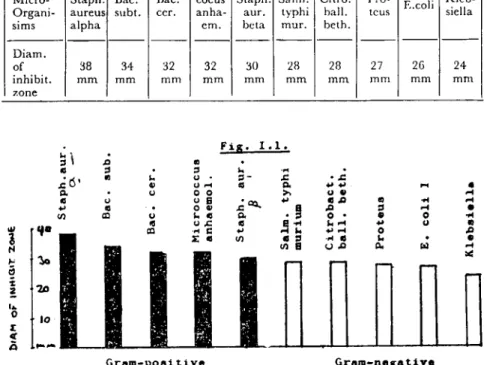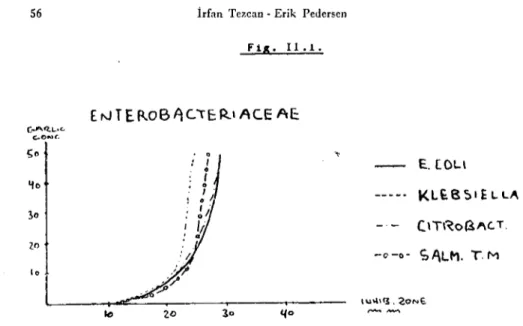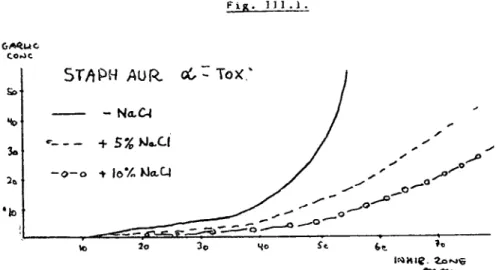A. Ü. Veterıner Fakültesi Besinkontrolu ve Teknolojisi Kürsüsü Prof Dr. Zeki Tolgay
THE INHmlTORY EFFECT OF GARLIC ON BACTERIA
*
İrfan Tezcan** Erik Pedersen
* * *
Sanınsağın bakteriler üzerine inhibitör etkisi
Özet: Bazı patojen ve toksik bakterilerin (Staplıylococcus, Jı1icrococcus, Bacillus, Salmo-mIla, Citrobac/er, Proteus, E.Coli ve li.lebseiella) gelişmeleri üzerine sarımsağın etkisi araştırıl-mıştır.
Gram negatif bakterilere nazaran, gram pozitif bakterilerin sarımsağa karşı daha du-yarlı oldukları tesbit edilmiştir. Bakterilerin gelişmesi üzerine bu inhibitör etki, bir familya içindeki çeşitli tür bakterilerde aynı olduğu saptanmıştır.
Sarımsağın bakteriyostatik etkisi üzerine sodyum klörürün potansiyel bir etkisi olduğu görülmüştür. Özellikle Staph)'lococcus aureus (alfa toxin) sodyum klorürün bu potansiyal etkisine karşı çok hassastır.
% 5 sodyum klorürle % i oranında sarımsağın birlikte kullanılmasının, gıda prescr-vasyonu konusunda bakteriyostatik etki bakımından iyi sonuçlar alınaeağı neticesine varıl-mıştır.
Suınnıary : Inhibitory effecı of garlic on a number of well known pathogenic and toxinogenic bacteria (Staphylococcus, Micrococcus, Bacillus, Salmoneıla, Citrobacter, Proteus, E.coli
and Ii.lebsiella) has been examined.
The gram positive bacteria were found to be more sensitive to garlie than the gram negative. The inhibitory effect was the same on different species within the same family.
Sodium chloride was found to have a potential effect on bacteriostatic ability of garlic. Espe(;iaııy Staphylococcus aureus (alfa toxin) is very sensitiye to NaCl's potential effect.
The practical aspects is discussed and the conelusion is that garlic valve in the food preservation must be taken into consideration when the garlic concentration is i%and the NaCl concentration is 5 % or more.
*This research was carried out at The Royal Veterinary and Agricultural Univer-sity, Copenhagen Denmark.
**Associate Professor at the Department of Food Control and Technology, Veteri-nary Faculty, University of Ankara, Turkey.
54 İrfan Tezcan. Erik Pederscn
Introduction
The purpose of this investigation was to study the inhibitory
effect of garlic on various bacterial species, known as potential
patho-gens or spoilers of sausages and similar products.
Garlic extract was prepared in an atomizer in different water
solutions (from 50 % to O.i %) of fresh French garlie. As test
orga-nisms were used representative members of the gencra
Microeocca-ceae, Enterobaeteriaceae and some Baeillus species.
Furthermore the potential effect of different NaCl
eoneentrati-ons was cxamined in order to determine the inhibitory effeet of garlie
at the different water activities commonly used in sausages. The
me-di um used was 5 % blood agar, incubation temperature was 3rc.
Material and Method
Bacterial eultures used were: Staph. aur. alpha-tox., Staph. aur.
beat-tox., anhaemolytie mieroeoceus, B.su btilis, B.cereus, SalmoneIla
typhimurium, Citrobacter ballerup bethesda, E.eoli I, KlebsieIla,
Proteus and as representatives for the enterotoxin producing strains
ofStaph.: Staph. A 100, Staph. B 56, Staph. C 361, Staph. D.315 and
Staph. epidermis 12.288.
All strains were obtained from the Institute of Vetcrinary
Micro-biology and Hygiene, the Royal Veterinary and Agricultural
Univer-sity, Copenhagen. Foıır hour old trypsine-digested ox heart broth
cultures were used in the experiment. And the effeet of the garlie
extraet was examined on blood agar according to the agar cup
met-hod, with a 12 mm hole drilled in the centre.
To eompare the potentiaI inhibitory effect of the different NaCl
concentrations, the blood agar was mixed with 5% and 10% NaCl
to obtain water activities of 0.97 and 0.94.
The agar was surface-inoeulated with the 4 hour broth culture
and garlic extraet was poured into the holc in the centre. Then the plates were stored at 4 oC for one hour to obtain good diffusion of the
garlic extraet before the bacterial multiplication startcd.
The plates were ineubated at 37"C for 24 hours and the di am eter
of the zone of inhibition was mcasured. The proportion between
the garlie eoncentrations and the diameter of the inhibition zone
The Inhihitory Effect Of Garlic On Dacteria
Results
The results obtained ın the experiments are shown below.
TABLE I. i. 55 Miero- Organi-sims Staph. Bae. aureus su bt. alpha Hae. ecr. M'
e~~~~- Staph. Saım.
i
Cilro. anha. am. typhi balı. cm. beta mur. bcıb. I'ro-ıe us Kleb. E.eoli sicila Diam. of inhibit. zone 38 34 mm mm 32 mm 32 30 mm mm 28 mm 28 27 26 mm ITIITl mm 24 mm;\
~.
cl ::l OCes' il ı..tl ~ U cl U•..
cl en a:ı u III,,-
LGı
a:ı l'l ı- ~ d i '2D ! i•. o lo ı: tCa
•...
Gram-polı1t1ve Fig. 1.1. ı.. ...•.
::ı- ..c • ..c III ~...
...
•
» •••tl .-4 OCCQ.•..
Cl~ il ..ı .-4. g
.;ı ::l .-4•
~ o.
ii o ..ı III!lt
10<.-4.•.
u il•..
....-4 o .;ı en cl ::l .••• III lo<.
ii en B u.;ı ~ rol .-4 :ıı= Granı-negattveA clear difference in the sensitivity bet\",'een Gram-positive and Gram-negative bacteria is noted (iO
%
garlie consentration).The dirference in the sensitivity of the species within the same gencra was examİned in different garlic concentration. The results were as fallow.:
TABLE Il. i
ENTEROBACTER IACEAE
Diameter of inlıibition zone, mm.
GarIic E.Coli Kleb Citrobaeter Salmoneıla Concentration i siella B.B T.M. 50 % 29 25 29 27 25 OL 27 23 26 25 /0 LO 0/ 22 21 22 23 /0 i % 13 13 14 14
56 ço 'lo :'>0 zn lo
İrfan TC7.canoErik Pcdcrscn
rta. ıLı.
ENTEp-oB
A
eıE: R.ı ACEAı::
E. [OLI
C\Tı~oıı ••••C. T.
-0-0- S.l\uı. T.M
20 3o
The table and the graph shf)w that Klebsiclla has greater rcsistance in high garlic con-centrations (capsule formation).
TABLO 11.2. Hacillus sp.
Diam. of inhibition wne, mm.
Garlic Concentration Bac. subtil. Bae. cereus.
_____ o_' ________ --- .- ___ o 50 OLlo 36 37 25 % 34 32 10 % 29 23 i % 13 13 8. ~~B\lL
B.
C.ERE.OSThe Inlıibitory Effect Of Garlic On Hacteria
TABLE II, 3
MICROCOCCACEAE
Staph. Carlie Staph. Staph. Sıaph. Staph. Staph. epiderm eone. A 100 II :ıf> C 361 D 315 D 494 12 288 --- --- -~-. ---.'i0% 40 40 42 48 3(; 40 25 % 34 36 36 3.1 33 35 LO % 31 31 32 28 29 32 i % 13 13 13 13 13 13 57 Fig. ıL). 5'0
BA
.
.
/-
S"APH A 100 'fo,
.!/
STAPH 8 5bı'ti!
ST A PH C 161 ~O,
: 0'0/ 2.0 ",i: Sr
A P\t O 31S" I,' .,' ,.' 5rAPı+ EPIDE"RM ıO n,"'U .10 qo So IN>iI\ı :ıa,,"E. \0 30 ""' •....•The graphs Fig. II. 1,2,3 show that sipeeies within the same
genus have equal sensitivitz; but the maximum effeet of garlie
differs (ef. fig.
ı.
1),In praetice a synergistic preservative effeet is obtained by using
garlie in combinatian with !'\aCI. The inhibitory elfeet of garlie on
Staph. aurelJS alpha toxin, Bac. eereus, and Salm. typhimurium in
rclevant salt concentrations was examined.
TABLE III, ı.
STAPHYLOCOCCUS AUREUS (alpha toxin)
Garlie Cone. .'i0 % 25 % LO % Blood agar (BA) .'i4 48 39 BA + 5 % NaCl 80 62 46 HA + LO % NaCl >85 Diam. of 74 inhibiıion .'if> zone, mm
---su İrfan Tczcan - Erik Pedcrsen
TABLE III. 2 .
BACILLUS CEREUS
Garlic BA , llA
-i-Cone:. BA 5 % NaCl 10 % NaCl
-_._---- .--- ---_._- --- -- .-.
__
._---50 % 39 .'A >85 25 % 36 49 >85 10 ol-,o 29 42 >85 TABLE III. 3. SALMO:--ıEI.LA TYPHIl'"IURtUM Garlic BA .. 13Ai'conc. llA 5 OL NaCl 10 % NaCl
Lo
---."--- --- ---_._-
---,---50 o'/0 31 55 No gr~~vth
25 o'/0 28 .10
10 % 26 37 "
The figurcs of Table III, 1,2,3 reprcscnted in a system of
coor-dinates.
Fig. III. i. shows a highly increased potential inhibitory cffect
of garlic in combination with NaCL. (Thc curve is flattened). it
appears from Fig. III. 2 and 3 that 5
%
:\'aCI gives the same maximumeffect of the garlic.
The increased bactericidal effect of garlic with 5% NaCl gaye
rise to an examination of the effcct of garlic concentrations below
5%. As test organisms were uscd cnterotoxic Staphylococcus aurcus
strains.
f'ig. 111.1.
5TAPH AUR ci,: ToX.'
sı>
'b - Na.~
~--
-
+ 5% tJ •.C.130
:2~ -o-o .•. lo./n tJa.c.ı
'10
'io Fig. III. 3.
SALMON
TYPHI
Ml)R)lJl"l - Na-C.I iı 1. + So;. f\l«.cı 10 Sc / --4-0---~.-'~O---~~~0---'-"-"'~ ~ 'ZıP""lI:' ,....-...
TABLE III. 4.BLOOD AGAR (BA) -i- 5 % KaCı Diam. of inhibition zont', mm.
Garlic Staph. Staph Staph. Staph. Staph. Staph. conc. A 100 B 56 C 631 D 315 D 491 cpiderm ---_.-_. .._--- -_..- --- --- ----_. --- ---5 MLo 29 30 29 26 29 31 1 % 13 13 19 15 13 13 0.1 %-1- <12 < 12 <12 <:12 <12 <12 0.01 oı/0 <12 <12 <12 <:12 <12 <12 -;-) Diameter of the ho le drilled in the centre: 12 mm.
60 İrfan Tezeaıı - Erik Pedcrsen
The tablc shows bactericidal action of 1(>:) garlic (and below) ın 5% NaCl environment.
The antibacterial effect of diallyl-disulphide was also testcd. A minor inhibitory effect was recorded with 1
%
diaııyl-sulphide solution for Salmonella, Staphylococcus aureus, Baciııus cereus and Pseudomonas.Discussion
it has been known for centuries that the storage life of food can be prolonged by the addition of spices. And a number of reports on the inhibitory effect of sriees on bacterial growth have been published.
In 1964, Pride (7) reports on the effect of dove oil and Özer and Özalp (8) described the bactericidal efTeet of garlic on Staph. aureus. The btter investigation was carried out in a liquid medium with 48 hrs old cultures, and an incubation period of 5 days (up to 15 days). Besides the effect of the garlic, a natural reduction of the number of bacteria may be expected.
in order to prolong the shclf-life of fresh camcl mea t, AI-Delaimy and Barakat (1) trcated fresh lean camel meat \vith 5, 10 and 15
%
(by wL) of fresh ground garlic segrnents and storcd at room
tempcra-turc (200-22°C), 12"C and in a refrigcrator (2°-3eC) respectively.
They foıınd that the period of shclf-life was increased 2,3 and more than 4-fold respectivcly, compared with the corresponding control samples. They stated that after 4 days starage at room temperaturc,
12days at 12°Cand 28 days refrigration, the meat treated 15 and 25
%
garlic shown no sign of any organoleptic spoilage. They clai-med that arter frying for 15 mirıutes the meat samplcs were found to be acceptablc in 'taste and flavoıır by local peopk in Saudi Arabia.Fletcher and co-workers (5) studies the inhibition of coagulase activity and growth of Staph. aureus in garlic extracts. They found that garlic extraet (I mg dry weight/ml) inhibited the coagulase reaction and increased the time of coagulation by a factor of
ı.
5, whereas 4 mg dry weightımı
increased the eoagulation time faetor by 2.75. it \Vas also shown by tlıese workers that 1.4 mg garlie (dry weight)ımı
redueed growth in nutrient broth while 5.6 mg dry weightI
ml was eompletely inhibitory. They did not observed these effeets until 8 h af ter exposure of the organisms to the garlie extraets. it was ' found that 5.9%,
more survivors among garlie treated miee compa-red to non-treated animals.The Inhilıilory Effccl Of Garlic On Raclcria (,ı
At the Fourth International Symposium on Food :\1icrobiology,
Gothenburg, 1964, Ingram et aL. (6) expressed a desire for a suitablc
procedure for estimating the preservative effect of natural inhibitors.
The concents of diallyl disulphide and mercaptanes in garlic
are well-known. A synthetic garlic oil consisting of
diall)' I-disul phide 85
%
allyl mercaptane 5 0/ LO dimethyl sulphide 2 o /0 buthyl thiocyarıate 5 0/ o
Cone. acetic acid 3 o;, o
has been used in the meat industry for a long time (2).
The general inhibitory ef/ect of enzymes by means of allyl groups
and SH groups has been studied in detail and the phenomenon
"biochemical lesion" defined by Peters (4) may be dt~alt with in a
more detailed discussion on the effect of the inhibitory mechanism.
The varying sensitivity of microorganisms to natural inhibitors
such as garlic is of considerable interest to the understanding of
keeping guality problems. Cavalli to (3) isolated a bactericidal agent
from garlic. He described the agent as a colourIcss substance
eorıtai-nirıg 40
%
sulphur, which was deeomposed by dry distillation. Thesubstancc in GdIcd aııicin. l\atural diaııyl dissulphide showed
prac-tically no antibacterial effeet.
Considering the minimum effect level of garlic demonstrated in
the present experiment, it is obvious that the concentrations of garlic
used in Danish meat industries (0.02 %) have no noticeable
irıhibi-tory cfIeet, with or without the addition of salt.
Th(~ Turkish produet "Pastırma" has a coating (çemcn) with a
very high corıtent of garlic providing the surface of the meat with
approximately iO 15 % garlic. I rı the presence of
ı
%
garlic and5
%
NaCl all the tested Staphylococcus strains were inhibited.The antimicrobial effect of the "natural" f10ra
(e.g.Lactobacilla-ceae) in fermented meat products resulting in a dccrease of pH and /01'
the antogonistic effect of spiees other than garlic (e.g.pepper), and
the effeet of the meat itself is a problem too eomplex to be discussed
62 İrfan T"eaıı -Eriı.. Pouersen
References
1- AI-Delaimy, K.S. and Barakat, M.M.F. (1971):
Antimicro-bial and preseJ"vatiueactiuity of Fesh ground garlic segments. J our. of the
Science of Food and Agriculture, 22 (2), 96-98.
2- Andersen, E. and Riemann, MJ. (ı 965) : Indııstriel
lemeds-middelkonseJ"l'ering. Tekniks Forlag. Kobenhavcn.
3- Cavallito, CJ. et aL. (1952) : In Tlze clzemistıy and Teclznology of Iood and foad products. Jacobs, M.B.: 2nd Ed. Yo!. 2.
4- Dixon, M. and Edwin, C.W. (1965) : En:çymes. Longmans Green and Co. Ltd. 2nd Ed. London.
5- Fletcher, R.D., Parker, B. and Hassett, M. (1974) :
İnlzibi-tion of coagulase activity and ı:rowtlz of Slaplzyıococcus aureııs by garlic extracts. Folia ~\1icrobİoıogica, 19, 494-497.
6- Ingram, M., Buttiaux, R. and Mossel, D.A.A. (i 964) : Gene-ral mierobiological coıısideretions in tlze clzoice of antimicrohialfood preser-vatiues. 4th Interıı. Symp. Food \1icrobiol., Gothenburg, Sweden. 7- Pride, D.G. and Clayson, D.H.F. (1964) : Some causes of
uızrelia-bility of essential oils as microbial inlzibitors infoodf. 4th Intern. Symp.
Food Microbio!., Gothenburg, Swedcıı.
8-- Özer,
i.
ve Özalp, E. (ı 962) : Sarmısalın enterotoxigenikslalilo-koklar üzerine bakterisid tesiri üzerinde araştırmalar. I.nnterotoxigenic Staj)/ıylococcııs aııreilS ,train 196 ile ilk denemeler. Türk Yet. Hek.
Dem. Dcrg., 188 189, 222-226.


